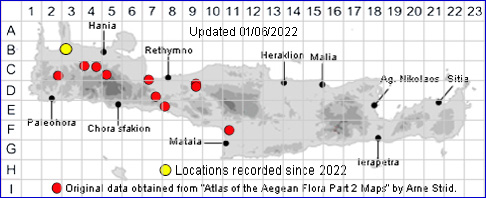
SPECIES DESCRIPTION
LOTUS PARVIFLORUS
Family and Genus:- See- LEGUMINOSAE/Sect. LOTUS
Common Names:- None
Homotypic Synonyms:- Dorycnium parviflorum
Meaning:- Lotus (Gr) The ancient name for various leguminous plants.
Parviflorus (L) Small-flowered.
General description:- Villous annual.
Stems:-
1) Up to 40 cm.
Leaves:-
1) Leaflets, 7-15 x 2·5-7 mm, obovate to oblong-lanceolate.
Flower:-
1) 3- to 7-flowered.
2) Peduncles, longer than the leaves; becoming recurved in fruit.
3) Calyx-teeth, 3-4 times as long as the tube.
4) Corolla, 5-10 mm, yellow.
a) keel, with a right-angle on the lower edge and a long beak.
Fruit:-
1) Legume, 4-6 x c. 1·5 mm, not or only slightly longer than the calyx.
a) valves, not contorting on dehiscence.
Key features:-
1) Corolla, not more than 18 mm.
2) Standard, not or only slightly exceeding the keel.
3) Calyx-teeth, at least 3 times as long as the tube.
Habitat:- Damp places in dry open shrubby vegetation, grassy patches in gorges,
on non-calcareous substrates, 0-450 m.
Distribution:- Mainly in the W & C Mediterranean region, including NW Africa.
Flowering time:- April to early June.
Photos by:- Christopher Cheiladakis & A. N. Other
